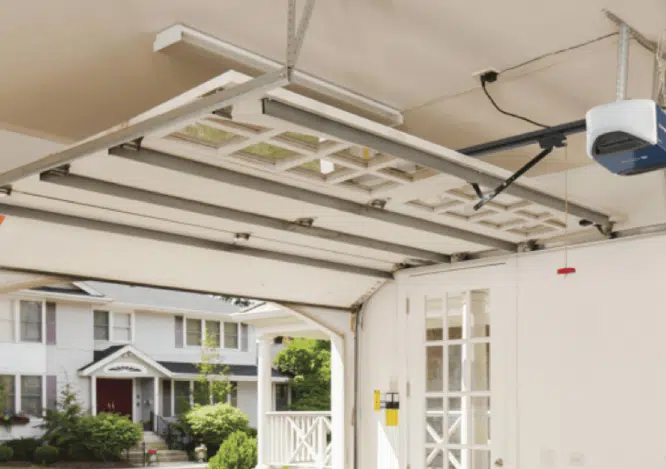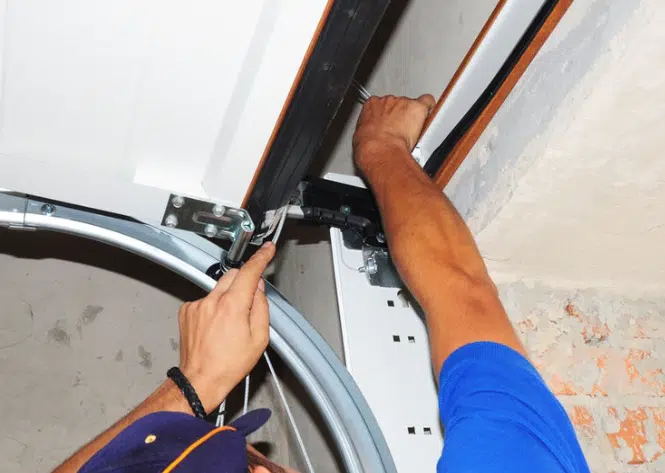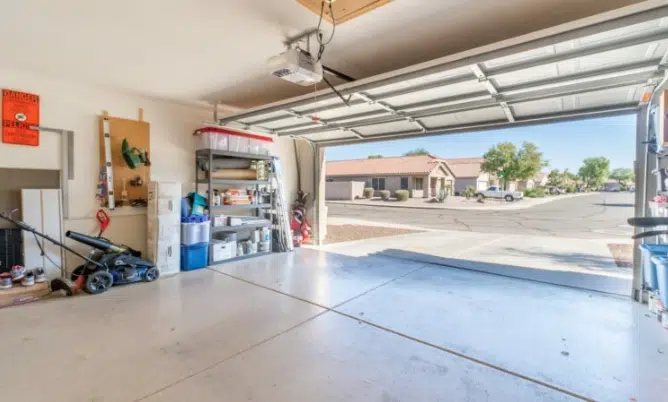Understand the anatomy of a garage door with this detailed guide to springs, rollers, tracks, and openers that power your system.
Garage doors are used daily, yet few homeowners understand what makes them work smoothly. When a garage door operates correctly, it feels effortless. But behind that seamless movement is a complex mechanical system with several components working in unison. Knowing the anatomy of garage door systems is the first step to recognizing problems early and ensuring long-term reliability.

The anatomy of garage door systems involves more than just panels and openers. It includes springs, cables, rollers, hinges, tracks, and safety sensors. Each part plays a vital role in maintaining balance, movement, and security. Regular maintenance of these components is crucial for maintaining the door’s functionality and safety.
Core Components That Define the Anatomy of Garage Door Systems
1. Garage Door Panels: The Outer Shell
Function: Garage door panels form the most visible and exterior part of the system. They are not only responsible for the door’s aesthetic appeal but also contribute significantly to insulation, protection, and structural strength.
Materials Used:
- Steel: Durable and low-maintenance, common in residential settings.
- Wood: Offers a classic, traditional look but requires regular upkeep.
- Aluminum: Lightweight and resistant to corrosion.
- Fiberglass: Resistant to dents and cracks, often used in coastal areas.
Common Issues: Damaged or dented panels can cause the entire door to misalign, leading to undue stress on other components like rollers, tracks, and springs.
2. Springs: The Power Behind the Movement
Function: Springs are arguably the most vital mechanical component of the garage door. They counterbalance the door’s weight, allowing it to open and close with minimal effort, whether manually or via an automatic opener.
Types of Springs:
- Torsion Springs: Located above the closed door, mounted on a metal shaft. Ideal for heavier doors and more durable.
- Extension Springs: Found on either side of the door, they stretch and contract to aid movement. More common in lighter, smaller doors.
Safety Note: Broken or weakened springs can make the door extremely difficult—and dangerous—to operate. Trained professionals should always handle spring repairs or replacements.
3. Tracks and Rollers: Guiding the Motion
Function: Tracks and rollers work in tandem to guide the door as it opens and closes. Tracks provide a channel, while rollers move within them, attached to each door panel.
Types of Tracks:
- Vertical Tracks: Run upward along the door frame.
- Horizontal Tracks: Extend into the garage ceiling.
- Curved Tracks: Connect the vertical and horizontal tracks.
Maintenance Tips: Keeping the tracks clean and free from debris, along with regular lubrication of rollers, helps ensure smooth and quiet operation. Misaligned tracks can cause jerky or noisy motion and should be realigned promptly to prevent further issues.
4. Cables and Drums: Supporting the System

Function: Lift cables, wound around cable drums, work alongside the spring system to raise and lower the door. These components are responsible for transferring the tension from the springs to the door itself.
Common Materials:
- Galvanized steel cables for strength and corrosion resistance.
Critical Safety Warning: Because they operate under high tension, frayed or broken cables are a serious safety hazard. Only experienced technicians should attempt cable adjustments or replacements.
5. Hinges and Brackets: Providing Structural Stability
Function: Hinges connect individual panels of sectional garage doors, allowing them to bend and fold as the door rolls along the track. Brackets secure various hardware components, including the cables and track supports.
Types:
- Center Hinges: Located between panels, allowing the door to flex.
- End Hinges: Positioned near the edges, often paired with rollers.
- Brackets: Support cables and anchor other components to the frame.
Maintenance Tips: Regular inspection for rust, looseness, or damage is vital. Replacing worn hinges and tightening loose brackets can prevent larger mechanical failures.
6. Garage Door Opener: The Automation Engine

Function: The garage door opener automates the lifting and lowering of the door. It includes a motorized unit, a drive mechanism, safety sensors, and remote or wireless controls.
Key Components:
- Drive Unit (Chain, Belt, or Screw Drive): Powers the motion.
- Safety Sensors: Prevent the door from closing if an object is detected underneath.
- Remote/Keypad: Offers user-friendly control and security.
Troubleshooting Tips: If the door fails to open or close properly, or reverses suddenly, the issue could stem from sensor misalignment, signal interference, or internal drive problems.
Smart Features and Safety Components in the Anatomy of a Garage Door
When it comes to home improvement and security, modern garage doors have become much more than just entry points—they’re high-tech systems equipped with smart features and essential safety components. Whether you’re upgrading your home or installing a new garage door, understanding the advanced technologies available today can help you choose a door that offers both convenience and protection.
Smart Garage Door Features for Modern Homes
Today’s smart garage doors often come with Wi-Fi connectivity, allowing you to control and monitor your door remotely through a mobile app. This means you can open or close your garage door from anywhere using your smartphone. You’ll also receive real-time alerts when the door opens or closes, adding an extra layer of security and peace of mind.
Some models even offer voice control compatibility with smart home systems like Amazon Alexa and Google Assistant. Integrated garage door cameras and motion detectors provide live video feeds and event-based notifications, helping you monitor deliveries, guests, or any suspicious activity around your garage.
Essential Safety Features in Garage Doors
While smart features add convenience, garage door safety is equally important. Modern systems include photoelectric safety sensors, installed a few inches from the ground on both sides of the door. These sensors emit an invisible beam across the door opening. If something—like a child, pet, or object—interrupts this beam while the door is closing, the system will automatically stop and reverse the door’s direction.
Another key feature is the auto-reverse mechanism. When the garage door senses resistance while closing—such as an obstruction in its path—it immediately reverses to prevent accidents or injuries. This safety feature is now standard in most residential garage door openers and is especially important for families with children or pets.
Maintenance Tips for Long-Lasting Performance
Regular maintenance is essential to keeping your garage door system running safely and efficiently. Keep the safety sensors clean and aligned to ensure they function properly. Even a small misalignment or dust accumulation can prevent the sensors from working correctly. It’s also important to inspect the garage door’s mechanical components—such as the springs, rollers, and opener motor—for signs of wear and tear.
Importance of Routine Inspection in Maintaining Your Garage Door System
Understanding the anatomy of garage door components is not just for emergencies. Regular inspections help you catch wear and tear early. Look for signs like slow movement, grinding noises, or uneven gaps at the bottom.
Routine lubrication of hinges, rollers, and springs can extend the life of the system. Check cables for frays, and tighten any loose bolts or brackets. For more advanced repairs, always consult a trained technician to avoid injury.
Frequently Asked Questions
What are the parts of a garage door?
A garage door typically consists of panels, hinges, rollers, tracks, springs (either torsion or extension), cables, and a garage door opener. The panels make up the door itself, and the hardware allows it to move smoothly. Safety sensors and weather seals are also essential parts.
What is the bottom part of a garage door called?
The bottom part of a garage door is called the bottom section or bottom panel. It often includes a bottom seal or weatherstrip to prevent drafts, pests, and water from entering. This seal compresses when the door closes to form a tight barrier.
What is the metal around the garage door called?
The metal around the garage door is typically called garage door trim or aluminum capping. It serves both decorative and protective purposes, covering gaps and shielding wooden framing from moisture. Some trims also come in vinyl or composite materials.
What is the strip around the garage door called?
The strip around the garage door is known as weatherstripping or a garage door seal. It’s designed to block air, debris, and water from getting in around the top, sides, and bottom of the door. There are various types, including rubber, vinyl, and brush-style seals.
What are garage door sections?
Garage door sections are the horizontal panels that make up the full height of the door. Most residential garage doors have 3 to 5 sections connected by hinges. These sections allow the door to bend as it moves along the tracks.
Conclusion
Understanding the anatomy of garage door systems helps you maintain safety and performance. From springs and cables to smart sensors and openers, each part plays a vital role. With proper awareness, you can identify problems early and avoid costly repairs.
Homeowners who are proactive about maintenance often enjoy longer-lasting garage door systems with fewer breakdowns. Knowing what’s happening behind the scenes gives you peace of mind and enhances your control over home security.
For expert diagnosis and repair, trust professionals who understand every detail of garage door systems. Grayson County Door & Gate is ready to help.
End Note
Grayson County Door & Gate delivers superior service and sources top-quality replacement parts, better than any other garage door company in Grayson County or the surrounding areas.
Our team has perfected the craft of garage door maintenance, helping you avoid frequent repairs and unnecessary hassle. With our skilled technicians, you’ll receive reliable, high-quality service at a price that’s both fair and affordable.
Explore our complete range of services to see how we assist homeowners with repair, installation, and maintenance. Want to learn more about our values and experience? Visit our About Us page. Check out our Gallery to view some of our completed projects. Ready to schedule a service? Contact us through our Contact Us page for fast and friendly assistance.
Grayson County Garage Door Repair
1940 Everheart Rd, Bells, TX 75414, United States
+19035007205

